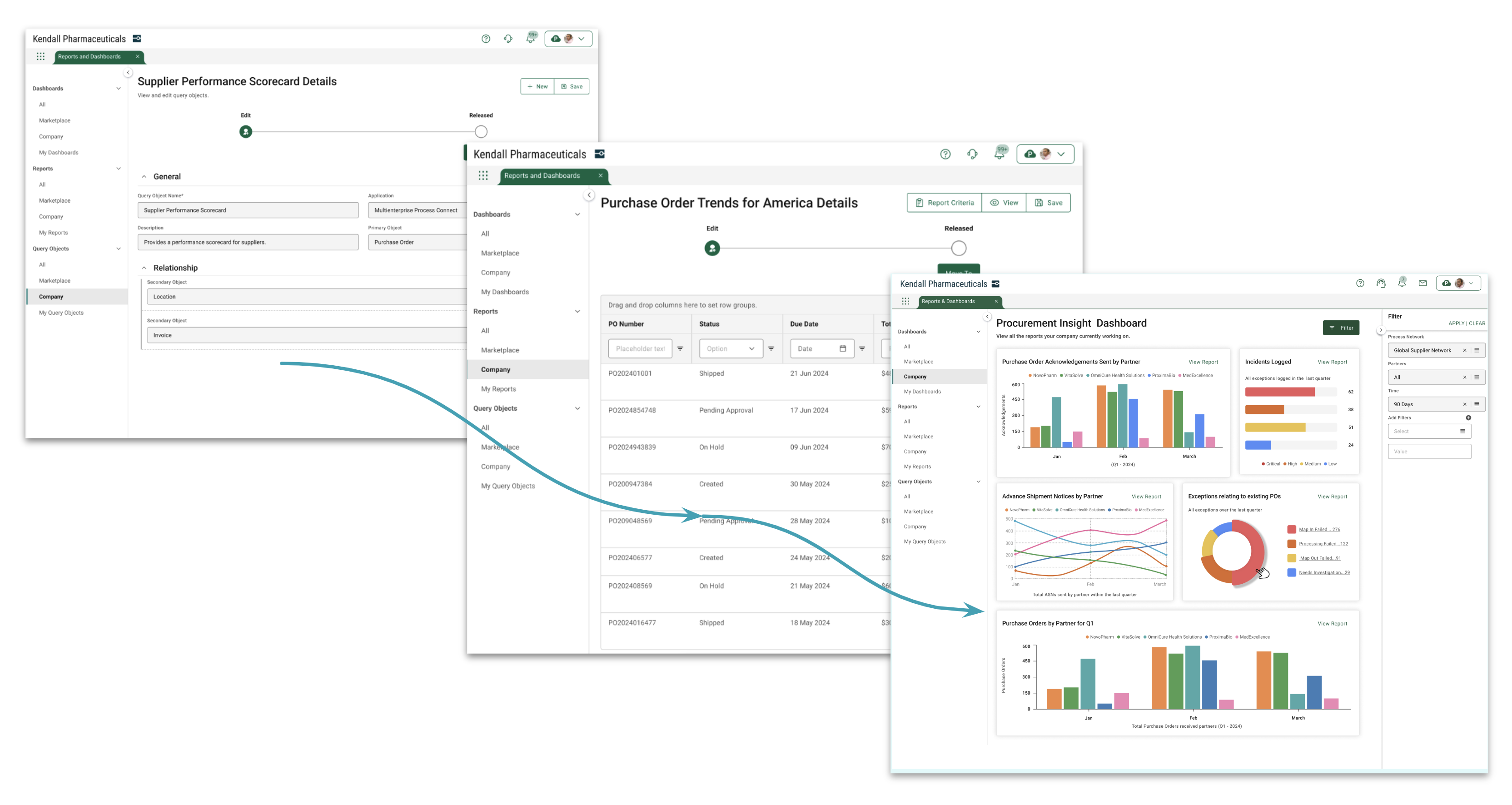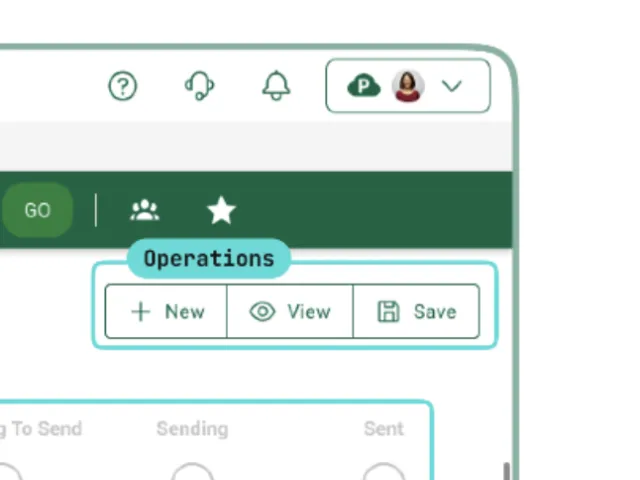Table of contents
OPUS Is the Only Platform as a Service (PaaS) That Works in Concert With a Digital Network That Orchestrates End-to-End Supply Chain Processes
TraceLink’s OPUS is an unparalleled platform as a service (PaaS) that combines the power of a metadata-driven, no-code solution with the world’s only end-to-end global life sciences supply chain network, driving superior business outcomes. Together, the OPUS Platform and TraceLink Network tackle complex supply chain challenges with unmatched capabilities that optimize system-to-system, system-to-person, and person-to-person business processes. This technology is pivotal in enhancing operational efficiency, mitigating risks, enabling informed decision-making, and strengthening overall supply chain agility and resilience.
Mastering Supply Chain Orchestrations: Coordinating Seamless, End-to-End Operations With Real-Time Data for Optimal Business Outcomes
Orchestrations are the coordinated and cohesive execution of multiple business processes across various stakeholders and organizations, each with its own defined workflows, to represent a broader business relationship. Orchestrations link supply chain networks by facilitating the execution of various business processes across many companies with varying relationships and unique challenges. Orchestrations are crucial for managing complex supply chain business ecosystems, enabling companies to quickly adapt to changes and optimize overall performance through real-time data exchange and increased visibility.

Different Partners within the supply chain face unique challenges. Supply chain orchestrations directly address these unique challenges through flexible integration options and configurable solutions which raise visibility across all supply chain processes. Some example orchestrations include:
- Commerce Orchestration – Coordinates procure-to-pay and order-to-cash processes, enhancing collaboration between supply chain partners. For example, the commerce orchestration can facilitate procurement transactions between pharmaceutical manufacturers and suppliers, enabling the exchange of forecasts, purchase orders, and invoices.
- Manufacturing Orchestration – Streamlines planning and production processes, including make-to-order/make-to-stock and procure-to-pay. For example, the manufacturing orchestration can support procure-to-pay transactions between pharmaceutical manufacturers and contract manufacturers, exchanging production schedules and orders for finished goods.
- Logistics Orchestration – Optimizes warehousing, fulfillment, and distribution processes. For example, the logistics orchestration can manage order-to-cash transactions between pharmaceutical manufacturers and logistics providers, handling orders, shipping notifications, and invoices, while also supporting vendor-managed inventory for customer networks.
Building Optimal Supply Chains With the OPUS Platform's Core Layers
The OPUS Platform is the only PaaS that enables organizations to create and configure multienterprise solutions for orchestrating end-to-end supply chain processes. OPUS supports both low-code and no-code design and development environments for solutions that enable orchestrations across the end-to-end life sciences supply chain.
The OPUS Platform is comprised of the following core elements:
- TraceLink Network
- Applications
- Solutions
- Integrations
- Reports and Dashboards
The following sections explore each element in more detail.
Enabling Real-Time Supply Chain Orchestrations Through TraceLink's Secure Network

The TraceLink Network is the foundational layer.
The TraceLink Network enables seamless integration between TraceLink customers and Partners through its unique network approach. By creating a single, authenticated digital twin for each company, the TraceLink Network ensures secure, real-time data exchanges, forging cohesive business process ecosystems.

"Integrate Once, Interoperate With Everyone™” on the TraceLink Network
TraceLink's Business-to-Network (B2N) Integrate Once model allows companies to integrate into the TraceLink Network a single time, eliminating the need for costly, unique point-to-point connections with each Partner. This innovative model equips companies to "Interoperate with Everyone," meaning each business can maintain its preferred integration format while seamlessly exchanging data with all network Partners. By leveraging a canonical model, Partners are insulated from changes, ensuring continuous, real-time data flow and reduced maintenance burdens.
Unlocking the Benefits of TraceLink’s B2N Integrate Once Model
TraceLink’s Integrate Once model provides the following benefits:
- 10 times faster integration
- Secure network onboarding process
- Reduced maintenance costs
- Real-time data sharing
- Flexibility to use any integration format
- Enhanced visibility across supply chain
Creating Digital Business Ecosystems With Process Networks
A Process Network is a business ecosystem consisting of a TraceLink customer (application Owner) and linked Partners (trade partners) working toward a shared business goal. Unlike traditional integrations, customers can maintain multiple process networks with different Partners without the overhead and latency of point-to-point setups.
Process networks are one of the 3 core building blocks of the OPUS Platform, alongside applications and solutions, which we’ll explore in more detail in the following sections. The main takeaway when understanding these core pieces is that a process network is a collection of linked Partners in the context of an application. Later in the article, we’ll explore how a single solution can be used across multiple process networks, allowing customers to configure orchestrations to meet the distinct needs of both Partners and Owners.

These Owner-Partner relationships are digitally forged within an app through Links. The TraceLink Network consists of countless Links that connect companies, people, processes, and systems, creating interoperable networks with specialized capabilities and secure role and policy governance. Whether you are a customer or Partner within a shared business process, you can only see and perform actions as defined by the rules defined.
Breaking Down Supply Chain Silos With TraceLink’s Linking Approach
Process networks enable sophisticated coordination and data exchange across companies, eliminating business process silos. TraceLink’s unique linking approach is key to breaking down these barriers, facilitating the seamless flow of data across multienterprise processes.

Each process network is configured by TraceLink Administrators, which activates secure data sharing, enabling supply chain orchestrations based on roles and Links.
The TraceLink Network uniquely connects companies, people, processes, and systems through secure, interoperable Links, enabling seamless, multienterprise collaboration that drives efficiency and adapts to the unique demands of every partner and process. Next, we’ll take a closer look at the role of applications within the broader TraceLink landscape.
Powering Supply Chain Solutions With OPUS Applications
OPUS applications deliver essential business functions, driving integrations and solutions to meet diverse market needs. There are both enterprise and multienterprise applications which provide shared instances of business process execution. Built by OPUS Developers, these "headless" apps operate without a user interface (UI) and have the sole purpose of delivering application functionality and logic.
Enabling Internal Efficiency With Enterprise Applications
Enterprise applications are designed for exclusive use within a single corporate environment with other internal systems (e.g. ERPs). Enterprise applications do not have linked Partners; however, they can be integrated with the company's other enterprise systems (e.g. SAP). Key examples of enterprise applications include Integration Manager and Administration.
Creating Shared Business Process Ecosystems With Multienterprise Applications
Multienterprise applications are shared instances of applications that foster digital collaboration by endorsing the exchange of data between an owning company and their supply chain partners via Links. This creates an integrated business process ecosystem that facilitates seamless orchestrations across multiple organizations, regardless of the role of that company in the broader supply chain.
Examples of multienterprise applications include Multienterprise Process Link (MPL) and Agile Process Teams (APT).
Maximize Supply Chain Orchestrations With Multienterprise Applications
- Cohesive Information Exchange – Simplifies communication and process execution between multiple supply chain partners.
- Scalable Ecosystem – Adapts easily to Partner-specific needs without complex custom integrations. Supports seamless expansion of business networks without adding integration overhead.
- Data Accuracy – Ensures synchronized, real-time data exchange across the supply chain.
Delivering and Configuring Unique Multienterprise Needs With OPUS Solutions
OPUS solutions amplify the functionality of applications, enabling organizations to advance their business processes with their unique requirements. As the apps themselves are "headless" (without a UI), solutions provide the user experience (UX) and configurations necessary to adapt to both customer and Partner needs. Solutions are powered by application functionality that ensures interoperable, multienterprise capabilities. This includes solutions offered by TraceLink, such as the Multienterprise Information Network Tower (MINT) which uses functionality from the MPL application.
Solutions encompass:
- Business objects and associated metadata
- Workflows
- Pages (complete with fields and actions)
- Menus
- Roles and permissions
- Policies
Metadata-Driven OPUS Solutions: A Flexible, Scalable Foundation for Complex Supply Chain Processes
Solutions are metadata-driven, providing a flexible and scalable foundation for managing complex supply chain processes. Metadata, the structured information that describes, manages, and organizes data, plays a key role in defining the attributes, relationships, and behaviors of the business objects used in orchestrations (e.g. purchase orders and invoices). Integral to the TraceLink data model, metadata governs the structure and interactions of a wide range of business objects, automatically driving user actions, associated workflows, and the user interface, including navigation. In short, OPUS solutions are completely object-driven, meaning a solution is focused solely around a business object and the corresponding information affixed to that object. For example, any business object comes with the following out-of-the-box, and it is all being driven off the data model:
- Characteristics – Define key attributes of a business object (e.g. a purchase order might include company address, order date, shipping address, and line items).
- Operations – Include the ability to create, view, edit, and delete instances of a business object.
- Workflow Integration – Allows the object to move through its defined workflow stages, ensuring process progression.
- Search, New, and View/Edit Screens – Screens designed for searching, creating, and viewing/editing business objects.
- Menu Items – Menu entries that list business objects by name, providing easy navigation to associated data.
- Automated Navigation – Seamless navigation between search, new, and view/edit screens.
- Roles, Permissions, and Policies – Control access to specific screens and operations, ensuring that only authorized users can interact with particular business objects and workflows.
OPUS Solution Environment (OSE) Empowers Designers To Configure and Deliver Relevant Supply Chain Solutions
Together, TraceLink’s rich data model and solution configurability provide robust options for addressing supply chain challenges, accelerating the delivery of digital solutions that solve industry problems. OPUS Solution Designers play a pivotal role in tailoring solutions to meet the unique needs of organizations and Partners. Using TraceLink’s OPUS Solution Environment (OSE), Solution Designers can harness no-code and low-code configurability to ensure seamless integration and adaptability across orchestrations.
For example, powerful configuration options for workflows provide businesses with the flexibility to shape process flows without needing to develop additional application logic. This flexibility allows companies to automate and optimize workflows for efficiency, scalability, and precision, ensuring they can quickly respond to changing business needs. Additionally, OSE supports more complex workflows, out of the box with no extra configuration required.
Unifying the OPUS User Experience With OPUS Ensemble
Key elements of the overall TraceLink solution experience include enterprise and multienterprise solutions along with OPUS Ensemble, TraceLink’s global experience.
Experience a Familiar, Intuitive Browser-Like Navigation
OPUS Ensemble is TraceLink's first fully metadata-driven solution, delivering a consistent user experience across all solutions. No matter which TraceLink solution you use, OPUS Ensemble ensures access to the same company context, help, notifications, and settings. With browser-like navigation, users can effortlessly switch between tabs, and sessions are restored exactly where they left off after logging back in, maximizing productivity. In short, OPUS Ensemble is the ever-present view for any user using a UI on the TraceLink Network with layouts and patterns familiar to all users who have used a web browser.
OPUS Ensemble includes the following:
A. User Context – Prominently placed at the top, ensures users always have their bearings. This fixed area provides a reliable and familiar interaction journey.
B. Navigation – Clearly guides users to their desired solution, network, or business object, facilitating easy content exploration while enabling parallel work through tabs.
C. Main Content Area – Provides a rich, interactive space for effortless engagement, whether consuming or collaborating within a solution.
D. Toolbar and Push Panel – Provides convenient access to key actions.
Navigate TraceLink's Exclusive Navigation Paradigm With OPUS Ensemble’s Network Composer
TraceLink’s navigation experience stands apart by giving users the power to manage process networks with just a few clicks. It seamlessly connects companies to their Partners across the supply chain, streamlining multienterprise collaboration and driving operational excellence. Powered by the network composer, the navigation flow is intentionally designed to digitally traverse real-world relationships and business processes, offering an unmatched experience.
See Introducing OPUS Ensemble for a deeper dive into OPUS Ensemble solution.
Solution UIs Enable Easy Access for Everyday Professionals To Participate in Orchestrations
Multienterprise solutions like MINT power orchestrations across logistics, manufacturing, commerce, and more. Users can interact with these solutions through a user-friendly interface, primarily via the main content area and push panel (within the global Ensemble experience), allowing them to efficiently consume information and complete tasks. With TraceLink's object-driven model, menus, screens, and navigation are automatically generated based on the data model, ensuring a consistent and intuitive user experience focused on the business object without any configuration needed, unless desired by the organization. This streamlines the design process while delivering a uniform and effective interface for end users.
Solutions Propel Multiple Process Networks To Meet Diverse Partner and Owner Needs
Process networks are tied to a single solution, however that solution can be used by multiple process networks, addressing the diverse needs of Partners and Owners. This flexibility allows customers to refine their solutions to meet the unique requirements of each network and enhance their orchestrations accordingly.
Navigating the OPUS Catalog: A Comprehensive Hub for Solutions and More
The OPUS Platform's catalog serves as a central hub, providing companies with access to a wide range of resources beyond only solutions. Using solutions as an example (e.g. Standard Solutions to Marketplace and Company Solutions), the catalog offers an intuitive starting point for retrieving, using, configuring, and managing solutions.
Standard and Marketplace Solutions Deliver Immediate Value Out-of-the-Box, While Company Solutions Offer Extensive Configurability To Meet Specific Needs
There are 3 types of solutions:
- Standard Solutions – Standard Solutions are pre-installed by TraceLink's application development team and are available for any company to use. These solutions provide baseline functionality that address common needs across multiple companies. They come with predefined pages, menus, roles, workflows, business objects, policies, and notification templates. They are available in the Standard Catalog, but cannot be directly configured by users, ensuring consistency and reliability in their deployment.
- Marketplace Solutions – Marketplace Solutions are available in the Marketplace Catalog and offer a broader range of functionalities designed to meet specific business needs. These solutions are not usable as-is; customers must save these solutions to make them configurable within the scope of your company. Once saved, you can modify and release them into your Company Catalog. This allows companies to start with a robust foundation that they can refine to meet their unique requirements. Solution Partners and TraceLink's own Professional Services and application development teams create Marketplace Solutions with the intention of designing to solve robust challenges both within your company and across your trade partners.
- Company Solutions – Company Solutions are highly configured solutions created by saving and modifying Marketplace Solutions or Standard Solutions. They are designed to the specific needs and processes of a customer's company. Company Solutions allow for extensive configuration of pages, menus, roles, workflows, business objects, policies, and notification templates, providing a flexible and adaptive solution that can evolve with the company’s changing needs. This configuration ensures that the solution aligns perfectly with the company's business demands. Solution Designers who are Solution Partners, TraceLink's Professional Services team, or citizen developers within your company can all configure Company Solutions.
Unleashing the Force of OPUS Solutions
OPUS solutions unleash the potential for organizations to elevate their digital supply chain strategies with a variety of impactful benefits:
- Configurability and Flexibility – Tailor solutions to fit the specific needs of your business processes, and adapt as your organization grows and requirements change.
- Scalability – Seamlessly expand solutions to meet growing business demands across multienterprise ecosystems.
- Interoperability – Ensure smooth integration and data exchange with trade partners for enhanced collaboration.
- Efficiency – Predefined solutions offer a quick start, with the ability to fine-tune for unique needs, reducing deployment time.
- Consistency – OPUS Ensemble and OSE ensures a cohesive user experience across all solutions, promoting ease of use with consistent and intuitive UIs and interactions.
Elevating Integration Options With Link Actions and Transforms for Cohesive Supply Chain Synchronicity
Integrations play a critical role in enabling seamless communication between diverse systems, ensuring data flows smoothly across business processes. TraceLink’s "Integrate Once, Interoperate with Everyone™" model empowers businesses to seamlessly connect with trade partners by eliminating the need for multiple formats and system-specific integrations (i.e. point-to-point). By leveraging our powerful integration tools, such as Link Actions and Transforms, you only need to integrate once—becoming agnostic to your Partners' formats and systems, just as they are to yours—enabling smoother, more efficient collaboration across the entire supply chain.
With out-of-the-box support for standard formats and the flexibility to accommodate Partner-specific requirements, businesses can also effortlessly scale and configure their workflows for their transactions, reducing errors and driving efficiency. This adaptability empowers organizations to streamline operations, enhance collaboration, and optimize processes across the supply chain, ensuring smoother, more reliable data exchange with all Partners.
By using Link Actions, Transforms, and the MINT UI, TraceLink provides a powerful, unified integration approach that simplifies digital connectivity and accelerates time to value, empowering businesses to achieve cohesive, scalable interoperability with every trade partner.
Regardless of the format or protocol used, transactions are processed through TraceLink’s canonical model and sent in the recipient's preferred format. This ensures interoperability across Partners, allowing each company to maintain their preferred method of integration while staying connected to the TraceLink Network. This capability helps supply chain partners achieve greater accuracy and keeps things moving by accessing timely, accurate data.
The key benefits of integrations include:
- Cohesive Processes – Frictionless data exchange between systems, minimizing errors, manual intervention, and redundancies.
- Enhanced Adaptability – Versatile support for diverse protocols and formats, enabling seamless integration with a broad spectrum of Partners and systems.
- Limitless Scalability – Effortlessly grow to accommodate new Partners or processes, without the need for intricate reconfigurations.
- Optimized Efficiency – Pre-built transforms simplify data handling, accelerating transactions and improving overall processing speed.
- Tailored Flexibility – Configurable workflows for transactions empower businesses to fine-tune integrations, aligning them perfectly with their unique operational needs.
Accelerate Enterprise Integration With Link Actions

Link Actions provide seamless, real-time API-based integrations with ERP systems, like NetSuite and Microsoft Dynamics, streamlining B2B transactions for end-to-end digitalization. These pre-built, reusable integration options minimize manual effort and reduce integration costs, enabling businesses to quickly configure systems to meet unique needs.
By leveraging Link Actions, organizations can integrate business workflows efficiently, ensuring consistency, scalability, and faster time to market. The flexibility of Link Actions supports rapid data syncing between external systems and MINT, while also providing the ability to tailor integrations to meet specific operational needs, driving enhanced business value and operational efficiency. Additionally, Link Actions enables the ability to seamlessly integrate a company’s external system with OPUS applications without the need to install any additional software or middleware. This no-software approach significantly simplifies the integration process.
OPUS Solution Designers can configure Link Actions to meet their organization’s needs in the XTT Link Actions solution and can access available Link Actions from the Marketplace Catalog.
Link Actions are a powerful mechanism for developing, integrating, and maintaining business workflows. By leveraging Link Actions, organizations can achieve greater efficiency, consistency, and scalability in their digital supply chain solutions, ultimately driving enhanced business value and operational excellence.
Ensuring Seamless Data Conversion With Transforms

Transforms enable asynchronous, flexible data exchange across systems and Partners, regardless of the transaction format. With support for out-of-the-box formats through the Transform Catalog and the ability to create Partner-specific transforms, businesses can ensure seamless data translation.
Within OPUS, transactions are modeled as business objects, allowing OPUS Solution Designers to define workflows and processing logic using standard OPUS capabilities. Customers can extend these transaction workflows via OSE, ensuring their orchestrations align with specific business needs. Transforms facilitate efficient and accurate data exchange, ensuring that all systems conform to the required schema and business process execution.
By leveraging Link Actions and Transforms, organizations can streamline operations, reduce integration costs, and ensure real-time data exchange with their Partners.
Advantages With Link Actions and Transforms
- Reduced Integration Time and Cost – Pre-built Link Actions eliminate the need for manual integration, reducing time and costs.
- Optimized Data Exchange – Transforms provide consistent data exchanges, supporting endless formats.
- Configurable and Scalable – Both Link Actions and workflows are highly configurable, allowing businesses to scale their operations as needed without added complexity.
- Enhanced Flexibility – Tailored transaction workflows help businesses align their integrations with their specific processes.
- Improved Operational Efficiency – Automated processes reduce manual intervention and errors, ensuring smooth system interoperability across the supply chain.
OPUS Reports and Dashboards Provide Unmatched Supply Chain Visibility

OPUS Reports and Dashboards provide a structured, no-code approach to accessing and visualizing global supply chain data. By integrating query objects, reports, and dashboards, TraceLink delivers critical insights through a user-friendly interface that doesn’t require knowledge of complex query languages.
Powered by the OPUS Reports & Dashboards solution, MINT Orchestrations come with out-of-the-box reports and dashboards that accelerate quality decision-making with visibility into compelling data. What sets TraceLink apart is its ability to tap into rich network data across orchestrations and the end-to-end supply chain. This enables a broader, interwoven view of orchestrations which is something that point-to-point systems cannot achieve. It provides real-time, cross-network visibility that can join information across complex processes, driving informed decision-making through broad supply chain performance monitoring.

Reports and Dashboards Enhance Supply Chain Visibility
By presenting key data through dynamic visualizations, these tools help key supply chain leaders navigate robust supply chain data. Whether analyzing performance, identifying bottlenecks, or tracking KPIs, Reports and Dashboards offer actionable insights that support real-time decision-making and process improvements. TraceLink Administrators can build and configure dashboards for users in their organization as well as for their Partners. Similar to solutions, query objects, reports, and dashboards can all be retrieved from TraceLink’s Catalog.
Query Objects Drive the Foundation of Reports
Query objects form the basis for data retrieval. Query objects define the data structure used in reports, outlining which attributes of objects are included in each report. They serve as templates that specify which objects and fields will be retrieved from the database, simplifying the data retrieval process. With this flexibility, TraceLink Administrators can create new query objects or use existing ones from their Company Catalog or Marketplace Catalog, adapting them to specific business requirements.
Interactive Reports Provide Detailed Data From Supply Chain Activity Across Multiple Sources
No-code reports offer a streamlined way to conduct detailed analysis on supply chain activities by retrieving data based on defined Query Objects. By retrieving data based on defined Query Objects, reports allow users to filter, sort, and apply computed fields for in-depth data manipulation. This enables users to generate actionable insights and focus on key metrics that drive supply chain performance.
Reports Deliver Powerful Features for Dynamic Experience
A dynamic report experience is achieved through a variety of features that enhance the reporting process:
- Interactivity – Reports include client-side modifications for faster performance, enabling users to interact with and refine data views on the fly.
- Configurable Criteria – Reports can be tailored to show specific attributes, date ranges, or process networks, providing relevant insights across multiple sources.
- Lookup by Value (LBV) field – An LBV empowers users to search for and retrieve specific records across multiple applications in a system by entering key values such as names or IDs. It serves as a powerful tool for quickly finding relevant data without manually searching through a large dataset. If records are not associated with the value entered, the value is stored just like a typical text box.
- Filtering and Sorting – Apply filters and sorting options to focus on specific supply chain data, narrowing down results for more targeted insights.
- Computed Fields: Perform dynamic calculations within reports, allowing users to generate custom metrics for in-depth analysis.
- Role-Based Security – Access to reports is secured by roles and permissions, ensuring that users only see data relevant to their access level.
Dashboards Provide High-Level Visual Summaries
Dashboards offer a visual aggregation of multiple reports in a single interface, allowing users to view a broad set of metrics at a glance. Unlike other dashboards, with TraceLink’s unique network advantage, users can filter across process networks where they can pull in information from various solutions and Partners. Each dashboard element represents a different report, with built-in functionality to drill down into specific data for more granular insights.
- Interactive Elements – Users can filter data across the entire dashboard using predefined filters such as process network or Partner selection, ensuring that all visualizations are in sync with the user’s context.
Cross-Network Visibility – Dashboards pull data from multiple process networks, providing a holistic view of supply chain performance.

Unparalleled Advantages of Reports and Dashboards
- Seamless Data Access – Query objects, reports, and dashboards streamline the process of accessing and analyzing data, reducing the need for technical expertise.
- Real-Time Insights – Dashboards update in real-time, giving users a current view of their supply chain health and allowing them to react quickly to emerging issues.
- Configurable Visualizations – Both reports and dashboards offer extensive configuration, allowing users to tailor data views to their unique business needs.
- Governed Visibility – User permissions control access to reports and dashboards, ensuring that sensitive data is only visible to authorized individuals.
OPUS Reports and Dashboards empower businesses to leverage comprehensive multienterprise supply chain data, providing unparalleled insights and real-time visibility that drive informed decision-making, streamline operations, and enhance overall performance across global networks.







